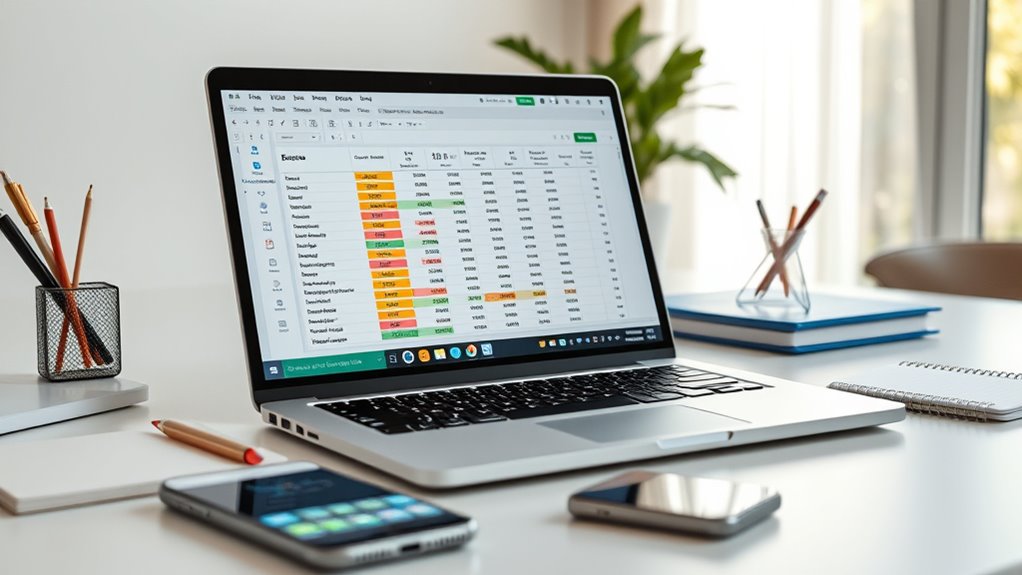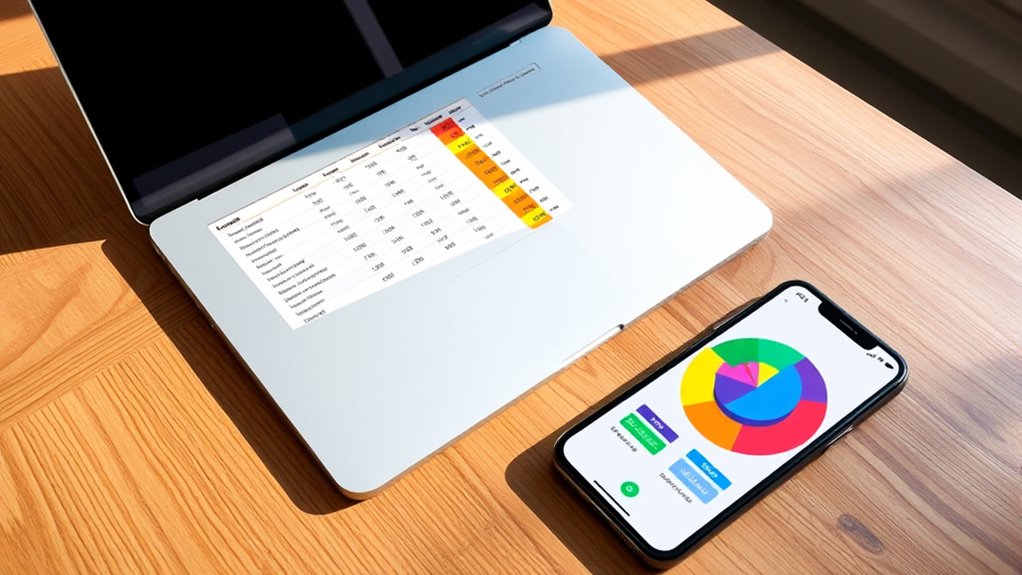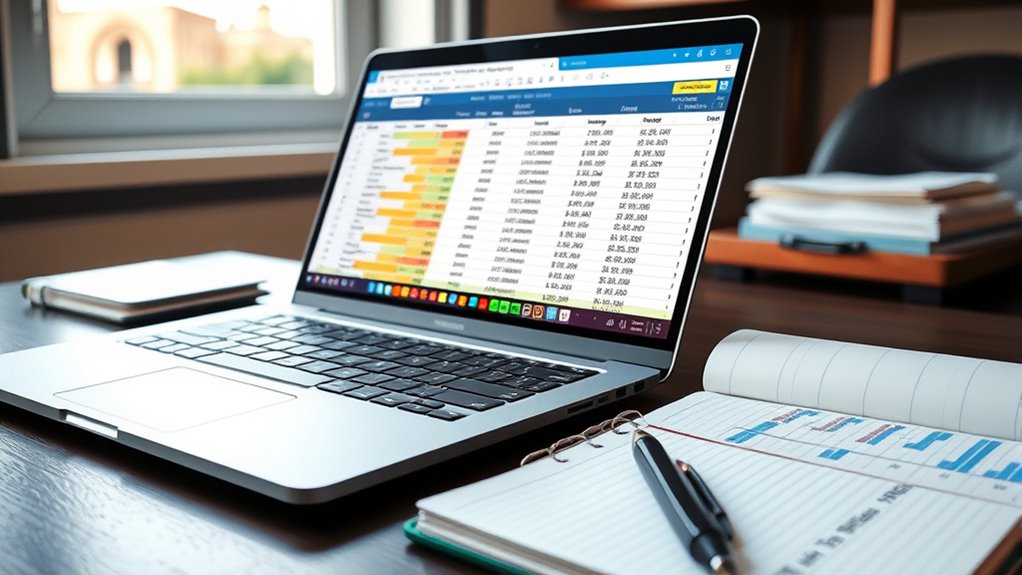To track expenses in real time with spreadsheets, set up a clear and user-friendly layout including columns for date, category, amount, and notes. Use data validation like dropdowns to minimize errors and formulas for automatic calculations. Connect your spreadsheet to online forms or apps for instant data entry, then visualize your spending with charts. Regular updates and maintenance help keep your financial picture accurate; learn more about optimizing your system below.
Key Takeaways
- Use online forms or mobile apps linked to the spreadsheet for instant, real-time expense data entry.
- Apply data validation and dropdown menus to ensure accurate and consistent input during real-time updates.
- Implement formulas like SUM to automatically total expenses and update totals instantly with new entries.
- Share the spreadsheet with multiple users to enable simultaneous, real-time editing and data sharing.
- Utilize visualizations such as charts to monitor spending trends and receive immediate insights.
Setting Up Your Expense Tracking Spreadsheet
To effectively track your expenses in real time, you need to set up a well-organized spreadsheet. Start by creating columns for each key detail: date, description, category, payment method, and amount. Use clear headers to keep everything straightforward. Consider adding a separate column for notes or tags to help categorize your expenses later. Choose a consistent format for dates and currency to avoid confusion. Use formulas to automatically sum totals, which makes monitoring your spending easier. Keep your spreadsheet simple initially, then expand as needed. Regularly updating this file ensures you stay on top of your finances. Additionally, understanding Types of Cookies can help you recognize how data might be tracked or shared when managing your financial information online. Incorporating visual representations like charts or graphs can further enhance your ability to analyze spending patterns and make informed decisions. Utilizing security measures such as password protection can help safeguard your sensitive financial data. With a well-structured setup, tracking your expenses becomes more manageable, giving you instant insight into your spending habits.
Designing a User-Friendly Data Entry System

Creating an intuitive input layout makes entering expenses quick and easy. Incorporate error prevention techniques, like data validation, to reduce mistakes. When you design with these points in mind, your system becomes more reliable and user-friendly. Additionally, understanding how user consent management influences data collection can help ensure compliance and improve user trust. Moreover, implementing features that accommodate various personal preferences can enhance user engagement and satisfaction. Considering shelf life considerations can also help in designing alerts for timely updates or reviews of expense data. Integrating mindfulness principles, such as focused attention, can further improve user experience by encouraging deliberate and attentive data entry.
Intuitive Input Layouts
Designing an intuitive input layout is essential for making expense tracking simple and efficient. You want users to enter data quickly without confusion or frustration. Start by organizing your fields logically—group related items like date, category, amount, and description. Use clear labels and consistent formatting to reduce errors. Incorporate dropdown menus for categories to streamline selection and minimize typos. Place important fields where they’re most accessible, such as at the top or center of the sheet. Leave enough space between input areas to prevent accidental edits. Use color coding sparingly to highlight key sections or to differentiate between types of expenses. The goal is a clean, straightforward layout that guides users naturally through the data entry process, saving time and reducing mistakes. Additionally, consider the user experience by testing the layout with a few users to identify any potential confusion or inefficiencies. Paying attention to ease of use can significantly enhance the accuracy and speed of data entry, especially when managing complex financial data like Lifevest Advisors’ investment options.
Error Prevention Techniques
Implementing error prevention techniques is essential for ensuring accurate and reliable expense tracking. You can reduce mistakes by using data validation rules that restrict entries to valid options, such as dropdown menus for categories or date pickers for dates. Protect cells that contain formulas or critical data to prevent accidental edits. Incorporate conditional formatting to highlight inconsistent or out-of-range entries, catching errors early. Use input prompts or instructions within the spreadsheet to guide data entry, making it easier for you to input correct information. Additionally, setting up automatic alerts or error messages can warn you when data doesn’t meet specified criteria. These techniques streamline data entry, minimize errors, and help maintain the integrity of your expense records. Sound healing principles can also be applied to create a calming workspace environment that improves focus during data entry tasks.
Automating Calculations for Instant Insights

You can set up formulas in your spreadsheet to automatically calculate totals, saving you time and reducing errors. As you update your expenses, these formulas will refresh instantly, giving you real-time insights. This process is similar to calibrating color accuracy in projectors to ensure optimal image quality. Additionally, maintaining accurate records can help identify financial trends, enabling better budgeting and decision-making. Implementing privacy policies and managing cookie preferences can also enhance your data management and security practices. Regularly monitoring your spreadsheet’s Wi-Fi connection can prevent data sync issues and ensure your expense data remains current.
Formulas for Totals
Using formulas to calculate totals in your spreadsheet allows you to automate your expense tracking and get instant insights. With functions like SUM, you can quickly add up expenses in a column or row, eliminating manual calculations. For example, typing =SUM(B2:B10) will give you the total of all expenses listed from cell B2 to B10. You can also use formulas to calculate subtotals for categories or periods, making it easier to analyze your spending patterns. Additionally, combining formulas with cell references helps you create dynamic totals that update automatically when you add or change data. This automation saves time and reduces errors, giving you a clear, real-time view of your financial situation. Understanding spreadsheet functions can further enhance your ability to monitor expenses efficiently, especially as AI-driven tools increasingly support financial management automation.
Dynamic Data Updates
To get instant insights into your expenses, setting up your spreadsheet to automatically update calculations as you enter data is essential. By using formulas that reference your data cells, your totals and summaries refresh instantly. This automation saves time and reduces errors, keeping your budget current. For example, entering a new expense automatically adjusts your total expenses and remaining budget. You can also set up conditional formatting to highlight overspending in real time. Here’s a simple example:
| Data Entry | Calculated Result |
|---|---|
| Expense | =SUM(B2:B10) |
| Income | =SUM(C2:C10) |
| Balance | =C11-B11 |
| Alerts | =IF(B11>C11, “Over Budget”, “Within Budget”) |
This setup ensures your spreadsheet provides immediate, actionable insights. Additionally, integrating automatic updates helps maintain an up-to-date financial overview, which is crucial for effective expense tracking and management. Incorporating real-time data synchronization can further enhance accuracy and efficiency in managing your finances.
Incorporating Real-Time Data Entry Methods
Implementing real-time data entry methods transforms how you track expenses by ensuring your spreadsheet always reflects the most current information. You can set up online forms or mobile apps linked directly to your spreadsheet, making it easy to input expenses instantly. Using tools like Google Sheets with Google Forms allows you or others to add data on the go without manual updates. You might also enable data entry via shared access, so multiple people can update expenses simultaneously. These methods reduce delays and minimize errors compared to manual data transfer. Plus, they streamline your workflow, encouraging consistent tracking. With real-time entry, you stay informed about your spending patterns, helping you make timely financial decisions and maintain better control over your budget. Incorporating market research can further help tailor your expense tracking to better understand your spending habits. Additionally, integrating automated data validation can improve accuracy and prevent entry mistakes. As store hours vary and influence shopping behavior, understanding local store hours can help you plan trips more effectively and optimize your expense management. Moreover, leveraging real-time data updates ensures your financial overview remains current, facilitating more responsive budgeting strategies.
Visualizing Spending Patterns With Charts

Visualizing your spending patterns with charts helps you quickly identify where your money goes and spot trends over time. Charts make complex data easy to understand at a glance, helping you recognize habits and areas to cut back. With a few clicks, you can create visual summaries that highlight your biggest expenses or track monthly changes. Incorporating wave and wind data can also provide insights into seasonal spending variations related to weather patterns. Consider these chart types to enhance your analysis:
- Pie charts to show expense categories
- Line graphs to display spending over time
- Bar charts comparing monthly costs
- Area charts for cumulative expenses
- Combo charts for detailed insights
Using these visual tools allows you to make informed decisions, stay motivated, and keep your budget on track. Visualizations turn raw data into actionable insights, making expense tracking more effective. Additionally, integrating yoga practice data can help you maintain a balanced approach to your financial and personal well-being. Exploring automation in business can also inspire you to streamline your budgeting process using digital tools and financial management software, making tracking expenses more efficient and less time-consuming.
Tips for Maintaining and Updating Your Spreadsheet Regularly

Regularly updating your spreadsheet guarantees your expense data stays accurate and useful for analyzing your spending habits. Make it a habit to log expenses daily or weekly to prevent backlog and errors. Review your entries for consistency and completeness, ensuring all categories are filled correctly. Set reminders or schedule specific times to update the sheet, so it becomes part of your routine. Keep your spreadsheet organized by using clear labels and consistent formats. Periodically back up your data to prevent loss. Adjust categories or add new ones as your spending habits change. Regular updates help you spot patterns early and stay on top of your budget. Staying consistent ensures your spreadsheet remains a reliable tool for managing your finances effectively.
Frequently Asked Questions
How Secure Is My Expense Data Stored in Spreadsheets?
Your expense data’s security depends on how you manage your spreadsheets. If you store them locally, they’re only as safe as your device’s security. Cloud-based options offer encryption and access controls, but you still need strong passwords and regular updates. Be cautious with sharing links or permissions. Ultimately, using reputable platforms with robust security measures helps protect your data from unauthorized access.
Can Spreadsheets Automatically Categorize Expenses for Me?
Spreadsheets can automatically categorize expenses if you set up formulas or use add-ons. For example, you can create rules to sort transactions by keywords or amounts. Some tools even integrate with spreadsheet apps, making this process more seamless. However, it requires initial setup and ongoing management. While not as advanced as dedicated apps, spreadsheets can still help you organize expenses efficiently with some customization.
What Are the Best Collaboration Tools for Shared Expense Tracking?
Imagine a sleek dashboard where your team’s expenses flow seamlessly like a well-oiled machine. You can’t miss a beat with tools like Google Sheets, which offers real-time collaboration and easy sharing. For more advanced features, apps like Airtable or Smartsheet let you visualize and manage expenses effortlessly. These tools turn chaos into clarity, making shared expense tracking smooth, transparent, and stress-free for everyone involved.
How Do I Recover Lost or Deleted Expense Data?
If you’ve lost or deleted expense data, don’t panic. First, check your spreadsheet’s trash or version history to see if you can restore an earlier version. If you use cloud storage like Google Sheets or Excel Online, they often save backups automatically. You can also try data recovery tools if the file was deleted from your device. Regularly saving backups prevents future losses and keeps your data safe.
Are There Mobile Apps That Sync With Spreadsheet Expense Trackers?
Imagine your expenses are like a busy highway, and you need real-time traffic updates. Many mobile apps, like Google Sheets or Microsoft Excel, sync seamlessly with your spreadsheets, giving you instant updates. You can scan receipts or input expenses on the go, ensuring your financial road stays clear. These apps help you stay in control, making it easy to monitor your spending anytime, anywhere, just like having a GPS for your finances.
Conclusion
By setting up your expense tracking spreadsheet, you’re like a captain steering your financial ship through calm and stormy waters. With a user-friendly system, automated calculations, and real-time data entry, you’ll gain instant insights into your spending habits. Regular updates keep your financial picture clear and current. Stay consistent, and your spreadsheet will become your trusty compass, guiding you toward smarter money decisions every day.








